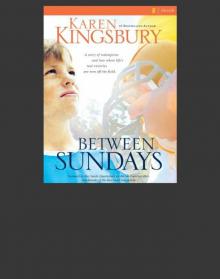- Home
- Karen Kingsbury
Final Vows Page 2
Final Vows Read online
Page 2
Most of the time Suzan’s sexual preference tended toward women—many of whom she had met while serving time in jail for various charges. But occasionally she would date men—especially those who looked like her.
Although Suzan sometimes sold Avon products and once in a while received five dollars for one of her Popsicle-stick lampshades, her primary means of support came from a monthly military pension for her role as a nurse in Vietnam and from a monthly government disability check. Even with that money, she could not afford to lease her one-thousand-dollar-per-month home in Dan and Carol’s stable neighborhood without her roommates. It seemed to Suzan’s neighbors—none of whom were fond of her—that the woman was always taking in new boarders. Word around the neighborhood was that some of these boarders contributed by paying a portion of the rent and providing drugs for Suzan’s weekly parties.
South Myers Street was lined with fruitless pear trees that in the summer fanned out to form a green archway over the road. Set back twenty feet from the sidewalk, the single-story homes were quaintly small with adequate front and backyards separated by beige cement block walls. This was the kind of neighborhood that typified Burbank.
For the most part, these rather plain homes were built in the 1950s and still housed the original owners. A majority of the residents along South Myers were getting on in years, their houses paid off and their children moved away. They could sometimes be seen sitting on their front porches in the middle of the afternoon sipping lemonade and discussing the virtues of being Republican.
But occasionally, as with the Montecalvo home, the houses had been sold to new families. As is often the case when this sort of turnover begins, some of the homes had been sold to people whom neighbors saw at odds with Burbank’s quiet image. Worse, some of the houses had been rented to unstable low-income people whom longtime Burbank residents found quite distasteful.
This was how neighbors viewed Suzan Brown. Although her rent included a weekly gardening service which maintained the property, Suzan often kept her garage door open allowing anyone who passed by to see the disarray inside. This was not an acceptable practice along South Myers Street. Also, shady characters frequently drove by Suzan’s home, stopping for only a moment, and returning to their cars counting what appeared to be currency. Drugs had never been a problem on the quiet street, but neighbors felt certain Suzan Brown was buying and selling something more than Avon.
Many of the neighbors had long since agreed that Suzan was a crazy woman. They even suspected her and some of her transient boarders of performing a handful of burglaries that had been happening in the neighborhood in recent years.
Because of that, they kept a close eye on the woman. Almost every night, often dressed in the same shorts and tank top, she would roll her wheelchair out the front door and into the garage at exactly 8 o’clock. Then she would spend nearly three hours making Popsicle-stick lampshades before going back into the house for the 11 o’clock news. Many nights her routine included looking for Dan and Carol sometime between 10 and 10:30. The couple walked nearly every evening, and watching them pass was one way Suzan gauged the time. After 10:30 Suzan stopped looking. By her assessment, the couple never walked later than that.
So when the Montecalvos strolled past her house that evening at 10:50, Dan did not notice whether Suzan was sitting in her garage. Perhaps, in keeping with her schedule, she had already gone in for the night, or maybe the couple had been too wrapped up in their conversation to notice her. Or perhaps, as defense attorneys and investigators would later contend, Suzan had been so busy orchestrating a neighborhood burglary that night that she had spent only an hour or so making her lampshades. Unaware of any of those possibilities or the importance they would have in later years, Dan and Carol continued their walk without any discussion of their quirky neighbor.
As the Montecalvos made their way around the block and back up South Myers Street toward home they did not cross the street until they had passed the house of their next-door neighbor, Ralph Atwater. The Montecalvos did this on purpose to avoid Ralph’s German shepherds. The dogs barked whenever anyone walked near Ralph’s property.
At 10:56 that evening, Ralph was caught up in a routine of his own as he prepared for bed and the 11 o’clock news. His wife had been asleep for some time, but he rarely went to bed before the news.
He pulled his striped pajama top over his head and turned back the covers on his side of the bed. Ralph’s wife, May, thought it odd that her husband liked to end his day watching the news. After all, there was nothing good in the news. Natural disasters. Crooked politicians. Senseless murders. Innocent people getting the raw end of the stick. Most people had enough real-life problems without getting tangled up in the sorry affairs of perfect strangers.
Ralph only laughed at his wife’s assessment. He thought the news was exciting. Amazing and terrible things happening to real people. Drama at its best. Never did he feel more in tune with the world around him than after watching the 11 o’clock news. He picked up the remote control, turned the television on, and hit the mute button. Fixing his eyes straight ahead at the small color set, Ralph waited.
At exactly 11 o’clock, the familiar faces of ABC’s news anchors flashed across the screen. Ralph hit the mute button again, allowing sound to accompany the pictures. The introductions rolled on in typical upbeat news fashion. Ralph rather liked the opening theme song of the network news. He turned the volume up a level, glancing over to be sure the sound wasn’t disturbing his wife.
But at 11:01, when the song was almost finished, a different sound caught his attention. It was frantic—a scream or cry perhaps, and it seemed to be coming from next door. Quickly Ralph hit the mute button again and turned toward the noise. For nearly ten seconds Ralph tried to make out the voices, but he could tell only that someone was very frightened and upset. For a split second the voices stopped and Ralph listened, perfectly still in the silent room. At that moment the quiet was broken by two sudden blasts of what seemed to be a car backfiring. Before Ralph had time to analyze the sounds, another single crack rang out.
Next to him, May sat straight up in bed.
“What happened?” she asked, her eyes filled with panic. “What was that?”
Ralph knew instinctively the sounds had nothing to do with a car’s exhaust system.
“Gunfire,” he whispered. “Sounded like three shots.”
May reached for her husband’s arm and he could feel her hands shaking. “What should we do?”
Ralph climbed out of bed and walked to the window that directly faced the Montecalvo’s home. The two families did not socialize together, but they were casual acquaintances and Dan had asked Ralph to water their lawn while they were in Hawaii.
“They don’t leave until tomorrow, do they?” he asked.
“No. Why, what do you see over there?”
“Nothing, nothing. But it sounded like the shots came from next door.”
“Oh, my God, Ralph. What if something happened to them?”
Slowly, he walked over and sat down on the bed. His mind raced with ideas of what he might do if Dan and Carol really were in trouble. But before he could form a plan, he heard sirens in the distance. In seconds, they were closer and Ralph was certain they were headed toward 315 South Myers, where the Montecalvos lived.
At that same moment, five houses down the street, the 11 o’clock news was four minutes old when Suzan Brown thought she heard something in her backyard. She, too, muted her television set and listened intently. It sounded like her woodpile had come crashing down, but now there was only silence. Suddenly she remembered the three loud sounds she’d heard a few minutes earlier. She began considering possible connections between those sounds and the noise she had just heard in her backyard when in the distance she heard sirens getting closer.
Back at the Atwater home Ralph went to the window again and watched as the first police car arrived. A uniformed officer with his gun drawn carefully climbed out, u
sing the car door as a shield. Keeping his head low, the officer darted silently across the street. Ralph was glued to the scene, horrified and unable to believe that a crime, maybe even a murder, had just occurred in his neighborhood.
At 11:06, with Ralph intent on the scene unfolding next door, the Atwaters’ dogs began barking. They were so loud he was sure they would ruin the officer’s cover.
“Darn dogs,” Ralph whispered as May joined him at the window. “Bark at anything.”
More than once Ralph had vowed to get rid of the dogs. The slightest thing could set them off and once they got started they could bark for an hour or more without letting up. They barked whenever anyone walked near the property.
Now something terrible had happened next door and his dogs were barking so loudly they were going to give the officer away. Ralph believed the gunmen were still inside the Montecalvo house. Unless of course they had fled the other way—northbound toward Suzan Brown’s house and away from his dogs.
After all, until the officer arrived, his dogs hadn’t barked once all evening.
Chapter 2
The call came through to the Burbank Police Department that evening at 11:03 and 40 seconds. Telecommunications operator Janet Brown answered the call and immediately the computerized 911 emergency system displayed the caller’s address and telephone number on Janet’s terminal screen. At the same time, the system’s reel-to-reel recording device clicked into action.
“Emergency nine one one, what’s your message please?” The young operator spoke quickly and calmly as she had been trained to do.
“Please help me, hurry up!” The man was hysterical, screaming and sobbing as he spoke, and Janet could not understand him.
“Sir, you can’t breathe? Is that what you’re saying?”
“We’ve been shot!”
“What?” Janet was straining to understand the man.
“Shot! My wife’s bleeding, she’s dying. Hurry!”
For a moment the man continued to sob into the telephone while Janet and her coworker, Faye Malcolm, began sending emergency calls to police in the area.
“Please. Please hurry,” the man pleaded.
“They’re on the way, sir, they’re on the way.”
Then, at 11:04 and 20 seconds, the caller hung up, apparently convinced that help would soon arrive.
Instantly, Janet redialed the telephone number that appeared on the screen while Faye informed police and paramedics that someone at 315 South Myers Street had just been shot.
At 11:05 the phone rang in Dan and Carol Montecalvos’ house. Dan answered it on the second ring.
“Hello?”
For a split second, Janet Brown thought she had the wrong number. Either she had caught the man between sobs or this was not the same hysterical caller she’d spoken with a minute earlier. Then, before Janet had a chance to identify herself, the man again began crying loudly.
“Hello?” he shouted. When the man recognized the voice of the emergency operator, he became furious. “Somebody help! My wife’s been shot and I’ve been shot!”
“Okay, stop crying now, okay?” Janet spoke as she would to a distraught child. “Stop—”
At that point the man began sobbing even harder, interrupting the operator. “My wife is dying here!”
“Okay, I need to know where your wife’s been shot, I need to know for the paramedics.”
“I don’t know,” the man sobbed. “It’s hard to tell. There’s blood everywhere. We walked into the house and somebody tried to kill us. They started shooting. There was two people . . .” The man paused a moment, sobbing loudly into the telephone. “Oh, my God. My wife is dying, lady, if you don’t get somebody here.”
“We are on the way, we are on the way. Did the people who were shooting get out of the house?”
“Yes.”
“Which way did they go?”
“I don’t know.”
“Did they leave out the front door?” Janet strained to understand the caller’s end of the conversation.
“Yeah, I guess. Out the front door.”
“How many were there?”
“Two.” The man was breathless, sobbing and gasping for air. “Hurry!”
“Units are on the way, sir. We’ve got paramedics coming to help you out. Okay? Sir?”
Janet turned to Faye, who had been monitoring the conversation and feeding information to officers en route to the scene. “He hung up.”
Faye announced over police radio, “Confirming your response. All units call is at three fifteen, three-one-five South Myers Street, 187 in progress. A man stated he’d been shot. They walked into the house and some subject started shooting. Possibly two subjects. Subjects left out the front door. Nothing further.”
With that statement, every available Burbank police officer immediately began responding. A 187 in progress meant someone was being murdered. Burbank is a town where police might go through an entire year with no more than one or two murders. In fact, police personnel liked to say that when an officer had an occasion to draw a gun in Burbank the incident became the talk of the station for several weeks.
At 11:05, when Janet was still talking with the caller, Faye Malcolm got word that the first officer had arrived at the scene just fifty-seven seconds after the call had come in. But it would be another seven minutes before police would enter the Montecalvo home.
Later, doctors would disagree about whether an earlier entry might have made a difference in Carol’s survival. Officers would contend that they were worried the suspects might still be inside, despite Faye’s police radio announcement that suspects had already fled. Regardless, by 11:05—while precious blood drained from Carol Montecalvo’s body—officers began arriving and placing themselves at various points in front of the Montecalvo house where they would wait a full seven minutes before making entry.
When the man hung up on Janet the second time, she leaned back in her chair and frowned at Faye. “There was something strange about that call,” Janet said.
“What?”
“It’s probably nothing,” Janet said. “He hung up on me a couple times.”
Faye was filling out paperwork on the call and still monitoring the officers’ progress at the scene. “Happens all the time. People are upset, someone’s hurt, they hang up the phone.”
“It wasn’t the hang-up, but the way he answered the phone when I called him back,” Janet said.
“What do you mean?”
“Well, it was like at first he wasn’t even upset at all. Just kind of, you know, ‘Hello?’ as if nothing was wrong. Then after maybe a second he was all of a sudden hysterical again.”
Faye shrugged. “Who knows. People get pretty weird in a situation like that. Don’t worry about it.”
Janet nodded and fell silent, listening to the police activity over the monitor. Later she decided she must have been overanalyzing the situation.
While Faye and Janet worked with the hysterical caller, Burbank police officers across the city had begun making their way to 315 South Myers Street. Officer Ron Caruso was heading the opposite direction less than a mile away from the location when dispatch announced a 187 in progress. Instantly he screeched into a U-turn, waiting until the car was completely under control before pushing the gas pedal to the floor. At that hour on a Thursday night, less than a mile from the crime scene, there was no need for sirens and lights. Caruso felt a wave of adrenaline rush through his body.
Fifty-seven seconds later he arrived in front of the house. With a response time of less than a minute, he thought it possible that the suspect or suspects might still be inside even if the victims believed they had gotten away. As he had driven up the street, he had seen no activity whatsoever. The entire neighborhood seemed asleep, with lights on at only a few houses—including the house where the shooting had occurred. In fact, as he parked across the street Ron noted that 315 South Myers was perhaps the only house on the block that was com
pletely lit up, the way Dan and Carol had left it when they took their walk.
This was unusual. Burglars typically broke into dark homes that seemed empty. He made a mental note of this detail, pulled his gun out from his waistband and climbed out, shielding himself with his car door. Keeping his head low, he darted across the street and waited behind a tall bush for backup units. The sound of distant sirens was growing closer.
Officer Rick Medlin was at the busy corner of Victory Boulevard and Alameda Avenue about four miles from South Myers Street when he got the order to report to a murder in progress. Three minutes later he was at the scene and noticed that several police cars had already arrived. He parked five houses away, drew his gun, and climbed out of the car. Quickly, he made his way from one front yard to the next using the houses as a cover, finally stopping at the house just south of the crime scene.
At almost the same moment dogs in the backyard of that property began barking and Medlin considered moving to a different location. But he decided to wait, ducking behind a four-foot wall separating the two houses.
Several officers were already scattered about the lawn of the house next door, their guns drawn. Medlin turned and watched the house, looking and listening for any sign of life. He noticed that two cars were parked in the driveway, which was adjacent to the wall he was hiding behind. Strange, he thought, breaking into a house with two cars sitting in the driveway.
Suddenly he saw movement in the hallway. Medlin glanced at the other officers but because of his viewpoint he appeared to be the only one aware of the motion. He raised his head and watched as a man with dark hair, his eyes cast downward, began walking down the hallway toward the door. For a moment he stood in the doorway, taking in the police activity on his front lawn. At that instant the man grabbed his right side and began limping down the steps. An officer across the street notified dispatch that a man had exited the residence. It was 11:09.

 Shades of Blue
Shades of Blue Divine
Divine Forever
Forever Summer
Summer The Snake and the Spider
The Snake and the Spider A Time to Dance
A Time to Dance Remember Tuesday Morning
Remember Tuesday Morning A Treasury of Miracles for Women
A Treasury of Miracles for Women Like Dandelion Dust
Like Dandelion Dust Brush of Wings
Brush of Wings The Tuesday Morning Collection
The Tuesday Morning Collection A Moment of Weakness
A Moment of Weakness Ever After
Ever After This Side of Heaven
This Side of Heaven Unlocked: A Love Story
Unlocked: A Love Story Take One
Take One The Red Gloves Collection
The Red Gloves Collection To the Moon and Back
To the Moon and Back Just Beyond the Clouds
Just Beyond the Clouds Oceans Apart
Oceans Apart A Baxter Family Christmas
A Baxter Family Christmas Fame
Fame The Beginning
The Beginning On Every Side
On Every Side Gideon's Gift
Gideon's Gift Forgiven
Forgiven A Kingsbury Collection
A Kingsbury Collection Found
Found Family
Family One Tuesday Morning
One Tuesday Morning Someday
Someday Take Three
Take Three Beyond Tuesday Morning
Beyond Tuesday Morning Unlocked
Unlocked Take Four
Take Four Never Grow Up
Never Grow Up Where Yesterday Lives
Where Yesterday Lives Two Weeks
Two Weeks When Joy Came to Stay
When Joy Came to Stay Halfway to Forever
Halfway to Forever Best Family Ever
Best Family Ever Sunrise
Sunrise Angels Walking
Angels Walking A Treasury of Miracles for Friends
A Treasury of Miracles for Friends Between Sundays
Between Sundays A Treasury of Miracles for Teens
A Treasury of Miracles for Teens A Thousand Tomorrows / Just Beyond the Clouds
A Thousand Tomorrows / Just Beyond the Clouds Finding Home (A Baxter Family Children Story Book 2)
Finding Home (A Baxter Family Children Story Book 2) Waiting for Morning
Waiting for Morning Chasing Sunsets
Chasing Sunsets Two Weeks: A Novel (The Baxter Family)
Two Weeks: A Novel (The Baxter Family) Coming Home
Coming Home Final Vows
Final Vows Sunset
Sunset Even Now
Even Now Fifteen Minutes: A Novel
Fifteen Minutes: A Novel Love Story
Love Story The Bridge: A Novel
The Bridge: A Novel One Tuesday Morning & Beyond Tuesday Morning Compilation
One Tuesday Morning & Beyond Tuesday Morning Compilation Truly, Madly, Deeply
Truly, Madly, Deeply The Chance: A Novel
The Chance: A Novel A Brush of Wings
A Brush of Wings The Beginning: An eShort Prequel to the Bridge
The Beginning: An eShort Prequel to the Bridge A Thousand Tomorrows & Just Beyond The Clouds Omnibus
A Thousand Tomorrows & Just Beyond The Clouds Omnibus A Time to Dance/A Time to Embrace
A Time to Dance/A Time to Embrace In This Moment
In This Moment Rejoice
Rejoice Coming Home: A Story of Undying Hope
Coming Home: A Story of Undying Hope